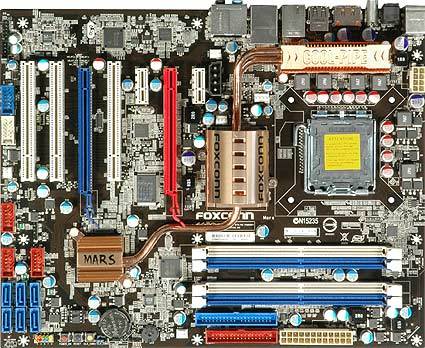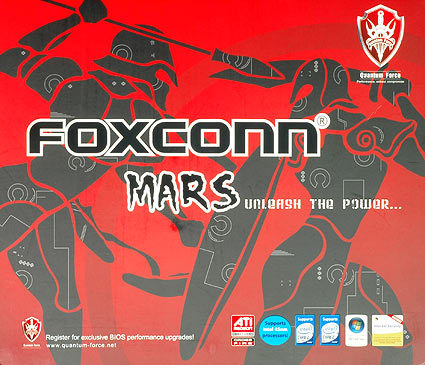Game on with Asus, DFI and Foxconn Mobos
Foxconn Mars
Foxconn's Mars gaming motherboard was named after Mars, who is the god of war in Roman mythology. Hence, we do not expect anything else but a motherboard to command and conquer the gaming world.
Its visual appearance is similar to that of any Asus motherboard. But Asus has etched Foxconn, as well as "Cool-Pipe" and "Mars," on the heat pipes, which serve to differentiate this product from other Asus motherboards. Compared to the Transpiper heat pipe from DFI and Asus' more flexible heat pipe with support for liquid cooling, Foxconn's heat pipe design is simpler. The design is based on a six-phase voltage regulator, while Asus and DFI rely on eight phases.
Foxconn also adds an UltraATA controller to provide an UltraATA/133 channel, since the ICH9 Southbridge of the 3 series chipsets doesn't support the legacy mass storage controller anymore. The second "channel" is routed to the back panel and provides an eSATA connector, which the other two contestants don't offer. Foxconn relies on a Gigabit Ethernet PHY by Realtek, while both Asus and DFI utilize Marvell components. All expansion slots are laid out the traditional way: There is the red x16 PCI Express slot, which is powered by 16 lanes, and the blue slot, which runs on four lanes. The two other x1 connectors can be used for single-lane expansion cards. You'll use one of the two x1 PCIe slots if you install a dual-slot graphics card, and another PCI slot (out of three) if you also use the second x16 slot for graphics.
There are three hardware switches on the motherboard: one power switch, a reset switch and a CMOS reset button. They are positioned close together, so be sure you don't accidentally push the wrong one. The pin panel is color-coded to help you make the right cable connections. The motherboard offers a total of 12 USB 2.0 ports; six of them are routed through the back panel, while the other six require a header with an adapter. The sound system isn't as sophisticated as the two detached solutions that Asus and DFI offer, but it's a fully-featured HD audio solution based on a Realtek PHY. There is a Firewire controller by Texas Instruments; one port is part of the back panel, the other one requires an adapter cable to use it.
Foxconn provides a small 40 mm fan, which can be attached to the Northbridge heat sink to cool it actively. Whether or not we used the fan did not have any impact on the overclocking results: The Mars maxed out at 450 MHz FSB speed at 1.6 V Northbridge voltage, while the two other boards reached 490 MHz (DFI) and 500 MHz (Asus) at only 1.55 V. Performance-wise, the difference between the three boards is too small and not really worth mentioning. However, the Mars was slightly more energy-efficient and required a few Watts less power in idle mode or under load.
Get Tom's Hardware's best news and in-depth reviews, straight to your inbox.
Current page: Foxconn Mars
Prev Page LANParty UT P35-T2R slide show And Details Next Page Mars slide show And Details
Patrick Schmid was the editor-in-chief for Tom's Hardware from 2005 to 2006. He wrote numerous articles on a wide range of hardware topics, including storage, CPUs, and system builds.

